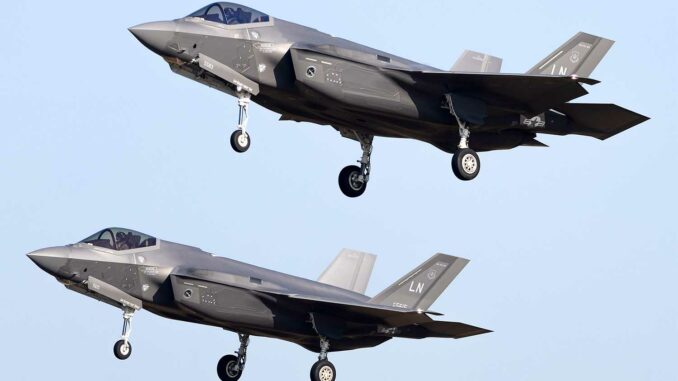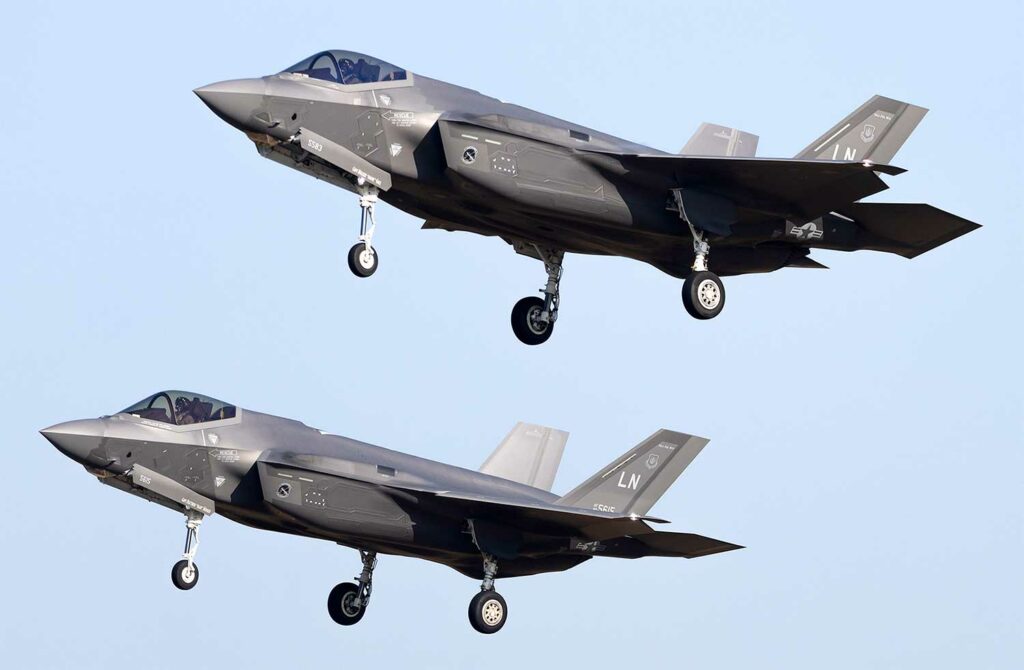
A CAMD system tested on the F-35 aims to prevent military-civilian mid-air collisions, filling a gap in TCAS for military aircraft.
A joint US/UK program is testing the CAMD (collision avoidance manual deconfliction) system on F-35s. It aims to prevent collisions between military and civilian aircraft in flight, a sector where fighter jets are not equipped with TCAS. CAMD relies on a high-frequency data link (20 to 40 updates per second). The system is derived from Auto-GCAS, which has been installed on F-16s since 2014 and on F-35s since 2019, preventing 12 accidents. Effective implementation on F-35 Block 4 is not yet planned. The aim is to respond to recent incidents involving collisions or near-collisions between civil and military traffic in order to enhance air safety.
CAMD technology
CAMD is a technology designed to fill an important gap: military aircraft such as the F-35, F-16, B-52 and Black Hawk do not have TCAS, the standard system on civil aircraft for avoiding mid-air collisions. These aircraft are therefore unable to automatically detect civil aircraft or take evasive action.
CAMD uses a dedicated data link between military and civilian aircraft, enabling position updates 20 to 40 times per second, according to AFRL data. This frequency ensures accuracy to within a few dozen meters and real-time tracking of relative trajectories.
This technology is derived from an existing system, Auto-GCAS, which was originally designed to prevent collisions with terrain. Developed since 1997, it was integrated into F-16s in 2014 and F-35s in 2019, and has prevented 12 confirmed accidents to date. CAMD adapts these algorithms to the air-to-air scenario, which represents a real step forward. Trajectory calculations and potential conflict detection use complex predictive models similar to GCAS, but applied to mobile air threats.
In practice, this data link requires compatible equipment on both aircraft, which is a challenge. The civilian sector must have a common interface, which does not exist today. The CAMD project therefore aims to establish a standard or protocol shared between military aviators and civilian pilots.
Ongoing testing
CAMD testing is being conducted on the F-35 test fleet at Edwards Air Force Base, California, coordinated by the Air Force Research Laboratory (AFRL) and with financial support from the UK Ministry of Defense, which is covering one-third of the costs, with the AFRL covering the remainder. This collaboration provides access to test aircraft, the Lockheed Martin production team, and the necessary infrastructure.
Recent incidents underscore the urgency of this innovation: on July 20, a Delta pilot had to maneuver abruptly to avoid a B-52H near Minot, North Dakota. On January 29, a US Army UH-60 Black Hawk collided with a PSA Airlines CRJ700 regional jet over the Potomac River in Washington, DC, killing 67 people. These events illustrate a classic collision between civil and military aircraft, which could have been avoided if a CAMD system had been in place.
The AFRL reports that without CAMD, there is no shared data link with the civilian world that would allow for an instant automatic response. CAMD must therefore operate manually, alerting the military pilot to take appropriate corrective action. The term “manual deconfliction” reflects this approach: the system alerts, but it is up to the pilot to correct.

Scope and impact of the CAMD system
CAMD is not yet planned for the F-35’s Block 4 program, the next major upgrade, but it has been retained as a requirement: despite risks of outright cancellation, it has survived internal trade-offs, ensuring technical access to the necessary resources. If CAMD is validated, it could reduce the risk of air collisions between civil and military traffic, a problem that accounts for approximately 24% of military aircraft losses, just behind accidents related to terrain, according to AFRL. This represents the potential saving of dozens of aircraft and lives.
The system should enable universal ground and air compatibility, paving the way for the adoption of a common protocol for high-frequency data link between military and civil aircraft. This would help reduce risk in high-density airspace, such as military training areas near busy civil corridors.
In comparison, the success of Auto-GCAS (a system linked to CAMD) earned it the prestigious 2018 Collier Trophy for its major contribution to aviation safety. CAMD is its air-to-air counterpart: if its effectiveness is proven, it could receive similar institutional support.
Current limitations
Despite its potential, CAMD remains highly experimental. It has not yet been tested in real mixed civil/military traffic, only on F-35 test flights. Civilian aircraft are not equipped with the device, which limits its application. In addition, the system operates in manual mode, which requires a human response to each alert, potentially slower than an automated system.
There are also regulatory barriers: civil authorities (FAA, EASA) will have to accept this type of data link. Without regulatory acceptance, global deployment is hypothetical.
Finally, as Kevin Price pointed out, if CAMD is not integrated into Block 4, it could be postponed indefinitely despite efforts to the contrary. The fact that it is not yet in the official plan is slowing down its adoption. One wonders whether bureaucracy and budgetary constraints will hinder a technology that is nevertheless viable.
However, it would be unwise to wait for a tragic incident to take action. The fact that collisions between military and civilian aircraft have cost all lives on board, as in January, justifies a proactive approach.
CAMD has the potential to revolutionize military-civilian aviation safety. But this requires a strong technical, financial, and regulatory commitment. The AFRL and its current partners appear to be working on this, but the challenge is clear: a future without catastrophic incidents in shared airspace is possible, provided that the current obstacles are overcome.
War Wings Daily is an independant magazine.